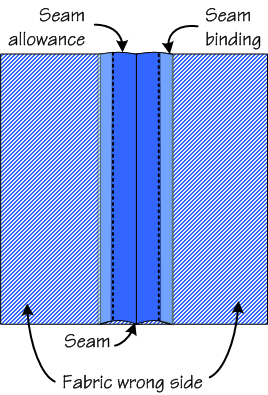Seams may appear straightforward, but they can be tricky things. Not in the sewing of them, because that's quite easy, but in deciding exactly what type of seam might be most appropriate. You might need a common seam, such as a clean finish seam, or an enclosed seam like one bound in bias tape. Perhaps an overlock or a French seam would suit you better. But how do you choose? Well, that depends on the type of fabric and the item you're sewing, of course.
If you're using a heavyweight fabric, and if the item in question is an unlined garment, you might decide upon a Hong Kong seam. This finish totally encases the seams, giving your garment a pretty, almost couture, finish on the inside. It should be noted that this particular seam finish works only on straight or moderately straight seams. Curved seams have to be notched to lie properly, and the notching means that a Hong Kong finish is not really possible.
But if your seams are mostly straight, and your seam is pressed open nicely, you can cut a continuous length of bias tape. The tape should be a full inch wide, maybe even a little wider, and it should be pressed open. This may seem a little wide for a seam, but the extra width gives you much needed excess when you start working on the wrong side of the seam. You can always trim it down later. You don't have to use actual bias tape. You can cut your own strips of fabric to use if you want something coordinated to the fabric you're using. Maybe even use remnants of the main fabric, or a pretty silk to make your seams even prettier. It's up to you. If you're cutting your own strips, 1½" is probably the best width to work with. Remember, you will be able to trim it later.
With the seam pressed open, line up the edge of the bias tape with the raw edges of the seam, right sides together. Stitch ¼" from the raw edge, but only on one side. Now open up this new seam, revealing the right sides of both the fabric and the bias tape. Press open, then fold the bias tape under the raw edge and press again. The seam should now be enclosed in the bias tape. To secure, stitch in place from the top side, making sure your needle hits precisely where the fabric hits the bias tape. This is called the 'ditch', and stitching here should make your stitches all by disappear. Nice and neat. Trim off the excess and repeat for the other side of the seam. This is your Hong Kong seam.
Though this seam is a little more work than the less fussy bias tape bound seam, it is neater and exactly the type of seam finish you might need if you're creating an unlined garment where the seams will occasionally be seen. If you want to jazz it up even more, consider using silk or another fine fabric as your bias tape. Though this isn't necessary, a finer fabric enhances the finish and makes your garment appear designer. Which it is. Designed by you, anyway.
Welcome to Aislin’s Designs—a cozy corner for crafters who love sewing, knitting, and crochet. Here you’ll find patterns, project ideas, tips, and tutorials to inspire your next handmade creation. Whether you're a beginner or seasoned maker, there's always something new to stitch, knit, or hook. Grab your yarn, thread your needle, and let’s get creative together!
Items posted on the main page are available for purchase unless otherwise indicated. If you'd like to purchase an item shown, send me a message indicating which country you live in and I'll quote you a shipping price. All payments are processed through Paypal only. If you're looking for a custom item, let me know the specifics and I'll quote you a total price. Custom items typically take 6 weeks to produce after payment is received. Keep this in mind when asking for custom orders.
